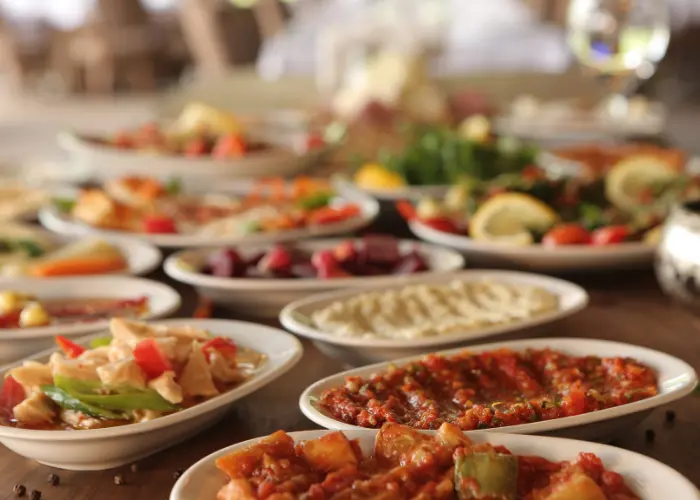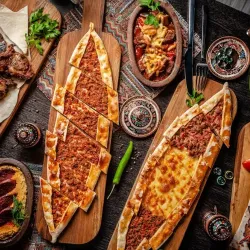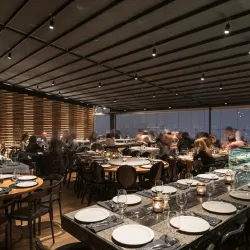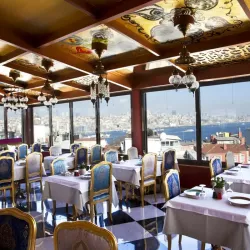Mezes are a key part of Turkish cuisine. Mezes are appetizers and cold starters consisting of vegetables, greens, lentils, pastes, yogurt, and cheese. Every table in Turkey has some type of meze at an evening meal, which the Turks like to savor for hours. Each meze has its own particular flavor and is served with fresh bread.
Mezes aren't for the starving, but for those who want to satisfy their eyes and taste buds. The main meal usually consists of kebabs or fish. It's fine to eat only meze or to get a personalized plate of smaller dishes called a "meze tabağı" Restaurants often have refrigerated display cabinets full of mezes, while others bring sample meals to the table. You don't get to sample them, only choose from what's available. Meze is difficult to choose from. Here are some traditional Turkish mezes.

Classics first:
Acılı Ezme
"Acılı Ezme" comprises mashed tomatoes, green peppers, onions, garlic, and lemon juice. Olive oil, red pepper paste, paprika flakes, pomegranate molasses, and mint add a Turkish flavour. Some are spicier than others, but "acılıl" indicates spicy.
Haydari
This delightful meze is built on yoghurt, garlic, and spices like dill and mint.
Eggplants
There are many eggplant-based mezes in Turkey. The layman may find the food names and preparations bewildering.
Şakşuka
"Baba ghanoush" is the most popular eggplant meze in Turkey and the Middle East. Eggplant is roasted with green peppers, tomatoes, parsley, olive oil, and tomato sauce.
Köpoğlu
"Köpoğlu" is a meal made of eggplant, green peppers, and tomatoes in a garlicky yogurt sauce.
Patlıcan Salatası
"Patlcan Salatası" means eggplant salad in Turkish. This salad comprises of smoked eggplant and roasted red peppers combined in olive oil and lemon juice. Some locations serve smoked eggplant, garlic, and yogurt as eggplant salad. Yourtlu patlcan salatas is this meze.

Beans
Hummus
Once you experience Turkish hummus, you'll never want it any other way. In Turkey, this chickpea dip is served on clay plates and topped with sizzling pastirma or pine nuts after being baked in the oven.
Barbunya Pilaki
"Barbunya pilaki" is a bean-based meze. Barbunya is the borlotti bean, often called the cranberry bean. Pilaki is a cooking method in which beans or fish are cooked with onions, garlic, tomatoes, carrots, and parsley in olive oil.
Taze Fasulye
"Taze fasulye" is long green beans cooked with onions, tomatoes, and olive oil. "Börülce" uses whole or shelled black-eyed peas.
Bakla
In Turkey, broad beans are either shelled or left in their green casings and prepared with sautéed onions, ample dill weed, olive oil, and lemon juice to become the meze called “zeytinyağlı bakla” or the whole mixture can be blended into a thick paste, which can be served in slices when cold or as a hot puree and is called “fava.”
Veggies
Denizbörülcesi
While samphire, or "deniz börülcesi" in Turkish, is succulent, it is blanched and dressed in olive oil, smashed garlic, and lemon juice like most seasonal greens.
Semizotu
This moderate meze has purslane, garlic, and yogurt.
Havuç Tarator
"Havuç tarator" combines sauteed grated carrots, garlic, and yogurt. In another form, zucchini is substituted for carrots, and the meze is named "kabak borani"
Atom
"Atom" is a meze of roasted peppers blended into garlicky yogurt, so beware
Frequently Asked Question
Is it popular to eat outside in Istanbul?
While the meals are generally eaten in the house, there are many possible places to eat in Istanbul that offer choices from traditional Turkish food to global fast food.
Are there any vegan options in Turkish cuisine?
Turkish cuisine is famous for working with plants and legumes as well as it is working with meat. Many vegan dishes can be found in the traditional cuisine of Turkey.
Are meals in Istanbul student-friendly?
There are many options for students to eat cheaply and quickly while still delicious like a home-cooked meal in Istanbul.
 English
English  Indonesian
Indonesian  Urdu
Urdu  Taiwanese
Taiwanese  Russian
Russian  Romanian
Romanian  Portuguese
Portuguese  Persian
Persian  Macedonian
Macedonian  Korean
Korean  Japanese
Japanese  Italian
Italian  Indian
Indian  Hungarian
Hungarian  Greek
Greek  German
German  Croatian
Croatian  Chinese
Chinese  Bulgarian
Bulgarian  Arabic
Arabic  French
French  Spanish
Spanish 





